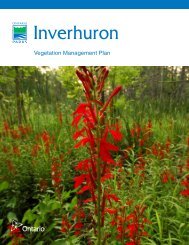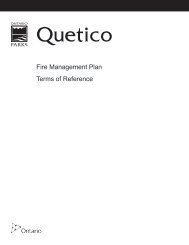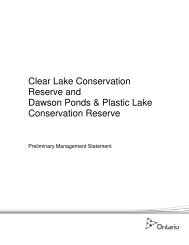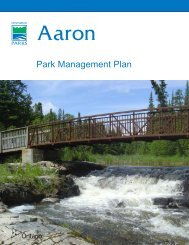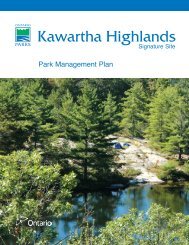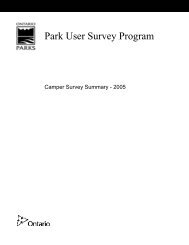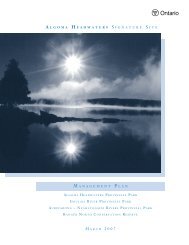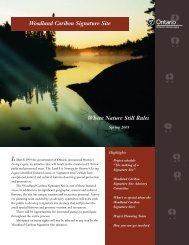Vegetation Plan - Ontario Parks
Vegetation Plan - Ontario Parks
Vegetation Plan - Ontario Parks
You also want an ePaper? Increase the reach of your titles
YUMPU automatically turns print PDFs into web optimized ePapers that Google loves.
6.0 SPECIES AT RISK<br />
<strong>Ontario</strong> <strong>Parks</strong> policy PM 11.03.02 states that the “preservation of species at risk in provincial parks is an inherent<br />
part of the Provincial Park system’s protection objective.” The policy further states that “in certain cases, passive<br />
management (i.e., non-intervention) of species at risk and habitat will not guarantee the perpetuation of that<br />
species. If this is determined, then active management will be prescribed” (OMNR 2001).<br />
Currently there are two records of Committee on the Status of Endangered Wildlife in Canada (COSEWIC) /<br />
OMNR listed plant species at risk in Inverhuron Provincial Park, i.e., Pitcher’s Thistle and Dwarf Lake Iris. Aside<br />
from the COSEWIC listed species, there are also seven provincially rare to uncommon (S1-S3) plants found at<br />
Inverhuron (Johnson and Parker 1975, Johnson 1981). A summary of the communities in the park where each is<br />
found and/or any key biological and management issues of each is provided in sections 6.1 to 6.9. A total of 37<br />
plants are also identified as being locally rare or uncommon in Southern Bruce County (Bruce-Grey <strong>Plan</strong>t<br />
Committee 1997), which are listed in Table 2 in section 6.10.<br />
There are also a number of rare, sand dune-associated invertebrate species within the park that bear<br />
consideration in vegetation management decisions. An outline of these species and management implications<br />
are provided in section 6.11. If additional species at risk are discovered in the park, management prescriptions<br />
will be developed and appended to the plan in consultation with the zone ecologist.<br />
6.1 Pitcher’s Thistle (Cirsium pitcheri)<br />
(G3, S2 Endangered)<br />
Pitcher’s Thistle is a provincially and federally endangered plant species that is a candidate for regulation under<br />
the provincial Endangered Species Act. The presence of Pitcher’s Thistle is well documented at Inverhuron<br />
(Johnson 2000, N. Toth, Personal Communication 2006). It is an Upper Great Lakes endemic and is not found<br />
anywhere else in the world (COSEWIC 2000).<br />
Pitcher’s Thistle grows on the open sandy habitat found on high beaches, foredunes, blowouts and beach<br />
ridges. It is adapted to living in a harsh environment, is somewhat tolerant of burial from sand (2-3 cm annually)<br />
and can withstand high soil temperatures. Prior to flowering, the species goes through three life stages as a<br />
seedling, rosette and adult, taking 3-11 years to reach maturity before dying.<br />
The Pitcher’s Thistle Lake Huron Dune Grasslands Recovery Strategy (Jalava 2004) defines the species’<br />
survival and recovery habitat as follows:<br />
Pitcher’s Thistle Survival Habitat<br />
“Survival habitat for Pitcher’s Thistle must include the area occupied by extant populations as well as a buffer<br />
zone for mitigating potential adverse influences of adjacent land uses. Because natural sand dynamics<br />
(colonization, stabilization and blowout) are critical functions to the dune system on which Pitcher’s Thistle<br />
depends, survival habitat must include such processes. Artificial structures that affect deposition of sand must be<br />
considered in recovery and management. A population viability assessment may be necessary to define<br />
population- and habitat-size thresholds necessary for self-sustaining populations, particularly along southern<br />
Lake Huron” (Jalava 2004).<br />
Pitcher’s Thistle Recovery Habitat<br />
“The recovery habitat of Pitcher’s Thistle should include sufficient lands to maintain self-sustaining populations<br />
and to permit future growth, expansion and migration. It may also include areas where populations formerly<br />
existed, if the habitat is still suitable or recoverable. Further research will be necessary to define the attributes of<br />
optimum habitats. Pitcher’s Thistle recovery habitat should have the characteristics listed above for survival<br />
habitat, and include management plans and strategies to prevent threats. Recovery habitat requires the<br />
complete range of dune zonation, protection of dune processes, low predator populations, un-fragmented areas<br />
of dominant grass species, and lack of threats (or the potential to enact mitigation measures)” (Jalava 2004).<br />
18





